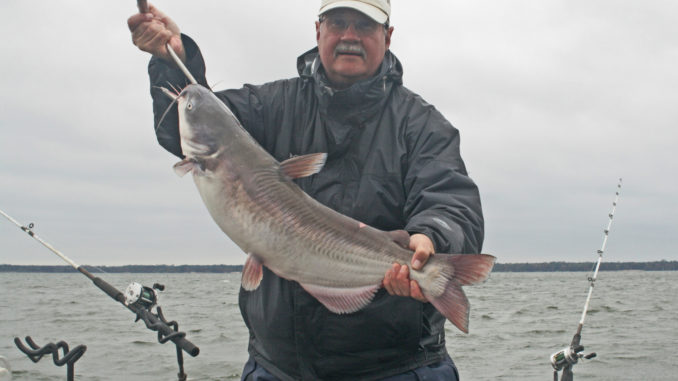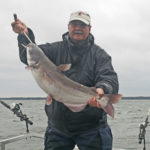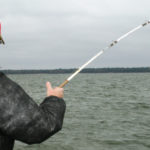
January is great time to sing the ‘blues’
Cold weather certainly doesn’t end good fishing on the Santee Cooper lakes; it actually triggers some outstanding fishing for some species — and the blue catfish is right at the top of that list. While January can certainly get cold, the weather triggers some exceptionally good fishing if you know where and what to do.
One of the favored targets of guides and local experts on both Lake Marion and Lake Moultrie is catfish, with the blue catfish being the prime target for most fishermen.
On Lake Marion, Capt. Alan Spence of Spence’s Spence’s Guide Service (803-478-5029) said the action is usually outstanding in January, and the lower end of the lake is his favored area.
“I’ll fish the lower portion of the lake and work the areas primarily where I find a combination of drops and big schools of shad,” he said. “Typically, at this time of the year, the threadfin shad will cluster into huge schools, and the big catfish will be there feeding on them. I like to find the combination of shad along a drop, such as near the channel of the Little River in the lower end of Lake Marion. Also, along the main river channel is good, plus, the lower end of the lake has lots of deeper holes scattered throughout the mid-lake area that are great targets. But sometimes just finding a big school of shad will be all you need.”
Spence said there are three ways he’ll fish for catfish at this time of the year. He said anchoring and fan-casting around the boat, vertical fishing over a school of shad and drift-fishing are all productive techniques.
“The right technique will vary from day to day depending on what the fish, forage and weather are doing,” he said. “Sometimes, the fish will be scattered in a general area around the forage, and it’s best to anchor and fan-cast. This is especially true if you’re in the area where there are lots of trees and stumps. You can effectively cover a wide area around the boat using this method.
“If I get on a tight group of fish in a small area, I can drop the bait straight down to a specific depth if they are hovering just off the bottom. Usually, the bigger fish will be holding just under the school of shad, with smaller fish in the shad school. But if the school of shad is higher in the water column, well off the bottom of the lake, I can fish a specific depth by fishing vertically and be very productive.”
Spence said drift-fishing in Lake Marion can be difficult in some areas because of the abundant woody cove underneath the surface, but there are some open areas where this works very well.
“If the fish and forage are scattered, sometimes covering more territory will work best, and that’s when I’ll drift fish,” he said.
Spence uses primarily cut bait, with cut herring, and shad his top picks. He said that most of the fish will average in the 10-pound class, but a lot of big catfish are caught as well.
Another guide who fishes both lakes but works Lake Moultrie frequently for blue catfish is Capt. Furman Casey out of Black’s Camp (843-753-2231). Casey said this is an excellent time of the year to catch not only lots of catfish but some huge catfish as well.
“As is always the case, the fishing for catfish, especially the blue catfish, centers around forage fish,” Casey said. “While threadfin and gizzard shad will be keys to success, there will be menhaden in the lake, and many of them will be at the lower end of Lake Moultrie, trying to get into the locks to get back down river to the salt water. These are ideal forage during cold weather for blue catfish, and these and the shad will often stack up in that 55-foot of water in front of the Pinopolis Dam and lock, and that’s where the catfish will congregate.”
Casey said that both drift-fishing as well as anchoring can be productive.
“During January, when you find big pods of forage, the catfish will usually be right in or just under them,” he said. “When that’s the case, you can often anchor and fish straight down and catch a lot of fish very quickly. However, if the fish are more scattered, you can drift-fish the standard drift rig and do very well. Some of the better catches can be made at this time of the year, but the wind can play a big factor in success and how effective you can fish. I love it when we get a couple of warmer days and the wind is right, there can be some fantastic fishing.”
A few other species will also be caught with some respectable fishing for largemouth bass in both lakes. The largemouth fishing, according to most guides, will be more of a big-fish fishery, with not many bites, but a good opportunity to hook a hawg.
The striper fishing can be outstanding; it sometimes peaks early in the month if the temperature doesn’t drop too fast. Last January, the action stayed great throughout the month because of the warmer winter. Target the forage as with the catfish for best results on striped bass. It is a great time to hook some of the biggest stripers of the year.







Be the first to comment